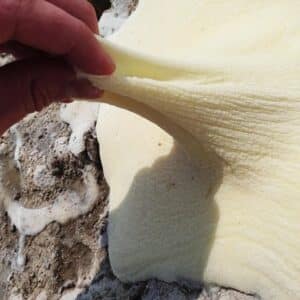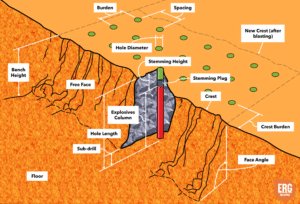
Sensitivity of Explosives
This article delves into the concept of explosives sensitivity, also known as initiation sensitivity, which is a fundamental property of explosive materials used in the
This article delves into the fundamental concept of Velocity of Detonation (VoD) and its profound significance in blasting activities within the mining and quarrying sector. Blasting operations serve as the linchpin for extracting valuable resources from the Earth’s crust, making VoD a critical parameter in the realm of explosives. VoD delineates the speed at which a detonation wave traverses through an explosive material, impacting safety and operational efficiency. Various factors, including chemical composition and density, influence VoD. Different explosives exhibit diverse VoD characteristics, ranging from a few thousand meters to kilometers per second.
Accurate VoD measurement techniques are vital for assessing explosive strength. These methods, including Dautriche and Photographic techniques, enable precise VoD determination. VoD’s importance in blasting activities cannot be overstated. It ensures safe timing and sequencing of explosions, minimizing risks such as misfires. Moreover, VoD influences fragmentation patterns, optimizing downstream processing, and mitigates environmental impacts by controlling ground vibrations.
Explosive products have varying VoD values, affecting their suitability for specific applications. Understanding VoD is key to designing efficient blasts. Proper explosive selection based on VoD also enhances safety, reduces flyrock risks, and aids in controlled blasting techniques. Ultimately, VoD knowledge empowers the mining and quarrying industry to achieve enhanced productivity, cost-effectiveness, and sustainable resource extraction practices.
Blasting activities play a vital role in mining and quarrying operations, facilitating the extraction of valuable resources from the Earth’s crust. The velocity of detonation (VoD) is a critical parameter in the field of explosives, determining the speed at which the detonation wave travels through an explosive material. This article aims to explore the concept of velocity of detonation, its importance in blasting activities, and its impact on safety and efficiency.

VoD refers to the speed at which the explosive shock wave propagates through an explosive material following initiation. It is typically measured in meters per second (m/s) or feet per second (fps). The VoD is influenced by various factors, including the chemical composition, density, and confinement of the explosive material. Factors such as the charge diameter and charge temperature also influence the VoD. Different explosives exhibit different VoD characteristics, which can vary from a few thousand meters per second to several kilometers per second (Persson, Holmberg, & Lee, 1996). According to Dobrilovic et al (2014) an increase in VoD is generally observed with an increase in charge temperature whilst the influence of charge temperature increases with an increase in hole diameter. Politzer & Murray (2014) identified the following four factors that explicitly influence the VoD and detonation pressure of explosives:
VoD measurement is a critical tool for industries and applications that involve explosives and energetic materials, as they help ensure safety, precision, and efficiency in various processes. These measurements are used for both practical applications and research purposes in these fields. For example, a research applicant for VoD measurements is to evaluate the performance of novel explosive formulation. VoD measurements are not only useful to evaluate energetic substances but can also be used to evaluate the performance of stemming material and stemming devices (i.e. Varistem Plug) as the change in confinement effects the overall performance of the explosive and thereby influences the VoD.
Measuring the VoD of explosives serves as a good indicator of the strength and performance of the explosive (Tete, Deshmukh & Yerpude, 2013). There are various types of VoD measurement techniques used globally (Table 1) with the main classifications being Point-to-point or Continuous methods (Zganec et al, 2016).
Table 1. VoD Measuring Techniques (Tete, Deshmukh & Yerpude, 2013)
| Measurement Technique | Description |
| Dautriche Method | The collision mark distance is marked from the midpoint as two detonation waves propagate from both ends of the explosive column and is suitable for measurement in unconfined spaces where cartridge explosive is used. |
| Photographic Method | The light emitted from the detonation wave (auto luminous process) is captured continuously in real time using streak and framing (high speed) cameras. The VoD is then measured from the motion captured. |
| Discrete Points Electric Method | This is a point-to-point method where the ends on sensor cables are inserted into the explosive column at varying distances and then to the VoD recorder where the start and stop signals are recorded. After detonation the timing clock initiates as the detonation reaches the first sensor and stop signals are sent upon the detonation reaching each sensor point. As the distance between sensor points are known, the VoD can then be calculated. This method is limited due to the discontinuity of the sensor in the explosive. |
| Resistance Wire Continuous VoD Method | This method follows Ohm’s Law (E=RI); where E=voltage, R=resistance and I=current; and was developed by USBM in the 1960’s. Wires with known resistance (single or double twisted wires) are used to measure the voltage drop (change in resistance with constant current) instantaneously at any point in time. This method is known to produce unusable or no results, especially when the distance path is not maintained, or sensors are not rugged enough. |
| SLIFER continuous VoD System | Shorted Location Indication by Frequency of Electrical Resonance (SLIFER) is a system that was developed originally by Sandia laboratories as a way of measuring the propagation of shock waves from a nuclear explosion. VoD is determined using the results of frequency that is monitored as a function of time, as the frequency of oscillation increases with a decrease in the length of the coaxial cable sensor wire. The system is restricted to a 66m wire per channel with each line requiring connection to an oscillator placed close to the hole. |
| TDR continuous VoD System | Known as one of the safest to use VoD measuring methods, the TDR continuous method was originally developed by Los Almos National Laboratory to verify nuclear reaction yields and stress velocities into surrounding medium. A narrow electric pulse is sent through a cable sensor with the end of the sensor detecting the reflective path and does not require shortening of the cable to acquire data. |
| Method based on Fibre-Optic | This point-to-point method uses optical fibre to detect the light signal accompanying the front of the detonation wave where the first cable starts the signal and the second cable (at a known fixed point) stops the timing clock. The VoD is then determined using the distance between the two fixed points and the time measured. |
The VoD plays a crucial role in ensuring the safety of blasting operations. It helps determine the timing and sequence of explosive initiation, ensuring that the detonation wave progresses as intended and that adjacent charges detonate in a controlled manner. By understanding and managing the VoD, the risk of unwanted events such as misfires, premature detonations, or erratic blasting outcomes can be minimized.
The VoD also influences the fragmentation pattern and the size distribution of the resulting rock fragments during blasting. High VoD explosives tend to produce finer fragmentation, while lower VoD explosives may result in larger rock fragments. Understanding these effects assists in optimizing blast designs to achieve desired fragmentation outcomes for efficient downstream processing.
Ground vibrations generated by blasting activities can also be influenced by the VoD of an explosive. Explosives with higher VoD values may produce higher-frequency vibrations, whereas lower VoD explosives tend to generate vibrations with a lower frequency content. By selecting explosives with appropriate VoD characteristics, it is possible to manage and minimize the potential environmental impacts associated with ground vibrations (Ash, 1993).

The actual VoD values can vary based on specific manufacturers, formulations, and conditions. The VoD is typically measured in meters per second (m/s) or feet per second (ft/s). The following VoD’s are generally measured:
Understanding the VoD of the explosive material is crucial in optimizing blast designs. By considering the desired fragmentation outcomes, safety requirements, and environmental considerations, engineers can select explosives with appropriate VoD values. This ensures that the energy released during the blast is utilized efficiently, leading to improved productivity and cost-effectiveness.
Proper selection of explosives based on VoD characteristics can help control the risk of flyrock. Higher VoD explosives provide better confinement and can help prevent the ejection of rock fragments beyond the desired blast area. Implementing quality blast design and stemming techniques (such as the Varistem stemming plug) further mitigate the risk of flyrock and ensure the safety of personnel and equipment.
The VoD can also influence the efficiency of controlled blasting techniques such as smooth blasting and pre-splitting. By selecting explosives with appropriate VoD values, engineers can achieve precise control over the blast pattern and minimize damage to the surrounding rock mass, resulting in improved productivity and reduced costs (Langefors & Kihlström, 1978).
The velocity of detonation is a crucial parameter in blasting activities conducted in mines and quarries. Understanding the VoD characteristics of explosive materials and incorporating this knowledge into blast design and execution helps ensure safety, optimize fragmentation outcomes, and control environmental impacts. By selecting explosives with suitable VoD values and implementing efficient blasting practices, the mining and quarrying industry can achieve enhanced productivity, reduced costs, and sustainable operations.
Ash, R.L. (1993) Blast Vibration Control. Prentice Hall.
Dobrilovic, M., Bohanek, V., Zganec, S. (2014) Influence of Explosive Charge Temperature on the Velocity of Detonation of ANFO Explosives. Central European Journal of Energetic Materials, Vol 11, Issue 2, pp 191-197.
Langefors, U., and Kihlström, B. (1978) The Modern Technique of Rock Blasting. Wiley Interscience.
Persson, P.-A., Holmberg, R., and Lee, J. (1996) Rock Blasting and Explosives Engineering. CRC Press.
Politzer, P., Murray, J.S. (2014) The Role of Product Composition in Determining Detonation Velocity and Detonation Pressure. Central European Journal of Energetic Materials, Vol 11, Issue 4, pp 459-474.
Tete, A.D., Deshmukh, A., Yerpude, R. (2013). Velocity of detonation (VOD) measurement techniques-practical approach. International Journal of Engineering & Technology. Vol 2, Issue 3, pp 259-265
Zganec, S., Bohanek, V., Dobrilovic, M. (2016) Influence of a primer in the Velocity of Detonation of ANFO and Heavy ANFO Blends. Central European Journal of Energetic Materials, Vol 13, Issue 3, pp 694-704.

This article delves into the concept of explosives sensitivity, also known as initiation sensitivity, which is a fundamental property of explosive materials used in the

The article explores the concept of scaled depth of burial (SD) and its significance in mitigating environmental impacts associated with blasting activities in mining and

Designing a blast involves the consideration of multiple parameters, and achieving the desired blasting outcome necessitates a thorough understanding of the interplay and interdependence of
Managing Director
Eugene Preis | eugene@ergindustrial.com
Operations Director
Reinhardt Steyn | reinhardt@ergindustrial.com
Administrative
Annette Schreiber |annette@ergindustrial.com
+27 60 805 6550
General Enquiries
info@ergindustrial.com | +27 60 805 6550